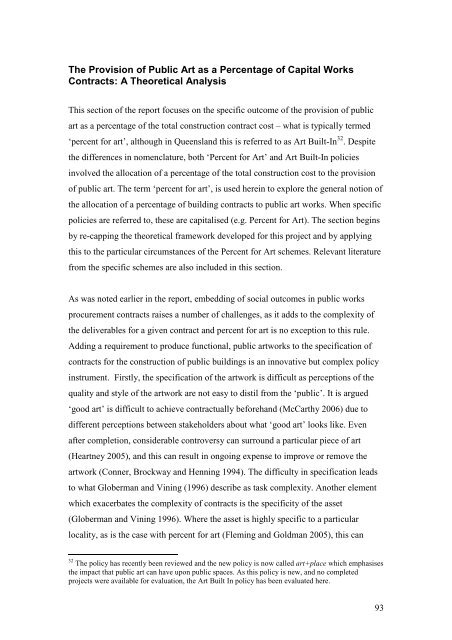Multi Outcome Construction Policy (final report)
Multi Outcome Construction Policy (final report)
Multi Outcome Construction Policy (final report)
You also want an ePaper? Increase the reach of your titles
YUMPU automatically turns print PDFs into web optimized ePapers that Google loves.
The Provision of Public Art as a Percentage of Capital WorksContracts: A Theoretical AnalysisThis section of the <strong>report</strong> focuses on the specific outcome of the provision of publicart as a percentage of the total construction contract cost – what is typically termed‘percent for art’, although in Queensland this is referred to as Art Built-In 32 . Despitethe differences in nomenclature, both ‘Percent for Art’ and Art Built-In policiesinvolved the allocation of a percentage of the total construction cost to the provisionof public art. The term ‘percent for art’, is used herein to explore the general notion ofthe allocation of a percentage of building contracts to public art works. When specificpolicies are referred to, these are capitalised (e.g. Percent for Art). The section beginsby re-capping the theoretical framework developed for this project and by applyingthis to the particular circumstances of the Percent for Art schemes. Relevant literaturefrom the specific schemes are also included in this section.As was noted earlier in the <strong>report</strong>, embedding of social outcomes in public worksprocurement contracts raises a number of challenges, as it adds to the complexity ofthe deliverables for a given contract and percent for art is no exception to this rule.Adding a requirement to produce functional, public artworks to the specification ofcontracts for the construction of public buildings is an innovative but complex policyinstrument. Firstly, the specification of the artwork is difficult as perceptions of thequality and style of the artwork are not easy to distil from the ‘public’. It is argued‘good art’ is difficult to achieve contractually beforehand (McCarthy 2006) due todifferent perceptions between stakeholders about what ‘good art’ looks like. Evenafter completion, considerable controversy can surround a particular piece of art(Heartney 2005), and this can result in ongoing expense to improve or remove theartwork (Conner, Brockway and Henning 1994). The difficulty in specification leadsto what Globerman and Vining (1996) describe as task complexity. Another elementwhich exacerbates the complexity of contracts is the specificity of the asset(Globerman and Vining 1996). Where the asset is highly specific to a particularlocality, as is the case with percent for art (Fleming and Goldman 2005), this can32 The policy has recently been reviewed and the new policy is now called art+place which emphasisesthe impact that public art can have upon public spaces. As this policy is new, and no completedprojects were available for evaluation, the Art Built In policy has been evaluated here.93
















